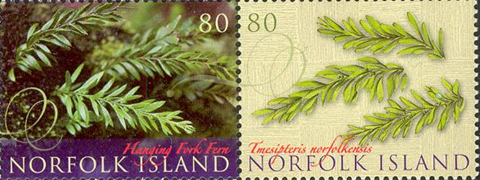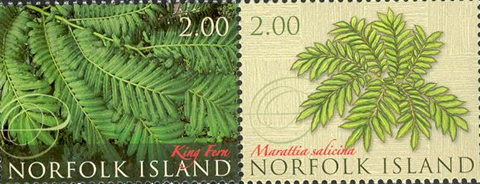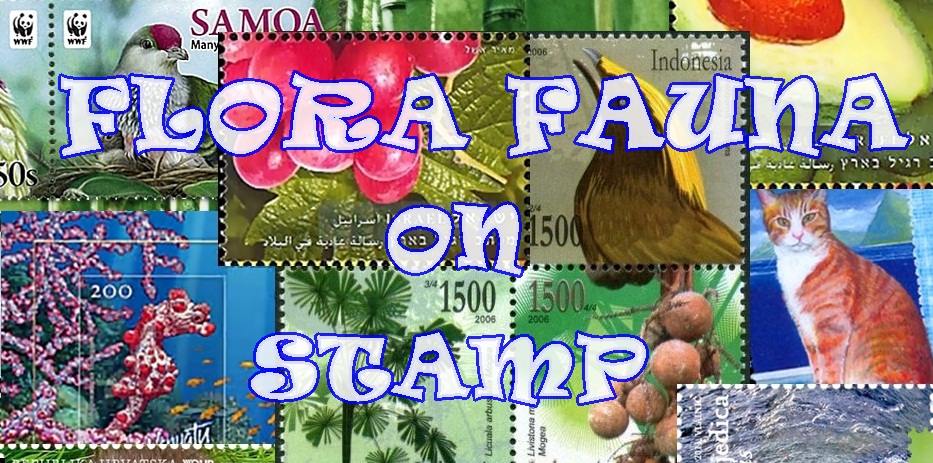Norfolk Island is the home of the majestic Norfolk Island Pine and some 40 other endemic plants including a variety of ferns. These are a source of considerable interest to scientists and botanists in that they can be found nowhere else occurring naturally. The Norfolk Island Post issued stamp set features the Rare Endemic fern and Indigenous fern in 4 se-tenant stamps. The issue stamps was designed by Mary Butterfield.
The most important group of ferns as far as conservation values are concerned are the endemic taxa. These are Asplenium dimorphum, Cephalomanes bauerianum, Cyathea australis ssp norfolkensis, Cyathea brownii, Lastreopsis calacantha, Pteris kingiana, Pteris zahlbruckneriana and Tmesipteris norfolkiensis. All of these exist as healthy populations or individuals in the wild. All are found in areas that already have legal protection. Some also occur in important populations in areas not currently protected.

Netted Brakefern –20c
Pteris zahlbruckneriana - 20c
Pteris zahlbruckneriana or Netted Brakefern is endemic fern in Norfolk Island and usually found in the forest on banks by the creeks. A number of plants in scattered populations in forest at higher elevation. Vulnerable but most of the populations are in protected areas.

Robinsonia – 50c
Asplenium austrasicum f. robinsonii – 50 c
Asplenium austrasicum f. robinsonii or Robinsonia is fern which held in a number of living collections and apparently though uncommon it was fairly widespread in the past. The plants appear to be sterile hybrids and if they arose a number of times this would explain the variability seen between individuals and widespread distribution of this uncommon plant. Asplenium australasicum grows as shrubby plant, with a rosette of yellow-green fronds which are 60 to 80 cm (24-32 in) long and 3 to 21 cm (1.2-8.4 in) wide

Hanging fork fern – 80c
Tmesipteris norfolkensis - 80c
Tmesipteris the "hanging fork fern", is a genus of fern-like vascular plants, one of two genera in the family Psilotaceae, order Psilotales, and class Psilotopsida (the other being Psilotum). Tmesipteris is restricted to certain lands in the Southern Pacific, notably Australia, New Zealand and New Caledonia.it can normally be found as short spiky dark-green fronds (10–15 cm long), often with lighter bag-like sporangia at the bases of some of its "leaves". The fronds emerge directly from the fibrous root-mats which clad the trunks of mature tree ferns such as Dicksonia and Cyathea. The word of Tmesipteris is taken from the Greek language, meaning a "cut fern", referring to the truncated leaf tips

King fern – $2.00
Marattia salicina – $2.00
King fern is indigenous species of fern to Norfolk Island (the type locality), New Zealand, New Caledonia, Cook Islands, Austral Islands, Society Islands and the Marquesas. King fern is in serious decline, seriously threatened throughout its range by feral and domestic cattle, wild pigs and goats. Large plants no longer exist except in areas where there has been rigorous control of animals.Propagation is difficult. King fern can be grown from spores, but this is extremely slow.King fern has distinctive visuals : the green cane-like leaf stalks are 1 to 3 metres long. The young fronds are protected as they uncoil by a large ear-shaped basal lobe at the base. The glossy, dark green fronds are 4 metres, sometimes 5 metres long and 2 metres wide. The juvenile fronds are less robust, and wilt quickly if exposed to sunlight.

No comments:
Post a Comment